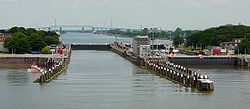Kiel Canal

The Kiel Canal (German: Nord-Ostsee-Kanal, NOK), until 1948 known as the Kaiser-Wilhelm-Kanal, is a 61 mile (98 kilometre) long canal in the German Bundesland Schleswig-Holstein that links the North Sea at Brunsbüttel to the Baltic Sea at Kiel-Holtenau. An average of 250 nautical miles (460 kilometers) is saved by using the Kiel Canal instead of going around the Jutland Peninsula. This not only saves time but also avoids potentially dangerous storm-prone seas. According to the canal's website, it is the most heavily used artificial seaway in the world; over 43,000 ships passed through in 2007, excluding small craft.[1]
Contents |
History
The first connection between the North and Baltic Seas was the Eider Canal, which used stretches of the Eider River for the link between the two seas. The Eiderkanal was completed in 1784 and was a 27 mile (43 kilometre) part of a 109 mile (175 kilometre) long waterway from Kiel to the Eider River's mouth at Tönning on the west coast. It was only 29 metres (32 yards) wide with a depth of three metres (ten feet), which limited the vessels that could use the canal to 300 tonnes displacement.

A combination of naval interests—the German navy wanted to link its bases in the Baltic and the North Sea without the need to sail around Denmark—and commercial pressure encouraged the development of a new canal.
In June 1887, construction works started at Holtenau, near Kiel. The canal took over 9000 workers eight years to build. On June 21, 1895, the canal was officially opened by Kaiser Wilhelm II for transiting from Brunsbüttel to Holtenau. A ceremony was held in Holtenau where Wilhelm II named it the Kaiser Wilhelm Kanal, and laid the final stone. The opening of the canal was filmed by British director Birt Acres and surviving footage of this early film is preserved in the Science Museum in London.[2]
In order to meet the increasing traffic and the demands of the German Navy, between 1907 and 1914 the canal width was increased. The widening of the canal allowed the passage of a Dreadnought-sized battleship. This meant that these battleships could travel from the Baltic Sea to the North Sea without having to go around Denmark. The enlargement projects were completed by the installation of two larger canal locks in Brunsbüttel and Holtenau.
After World War I, the Treaty of Versailles internationalised the canal while leaving it under German administration. Adolf Hitler repudiated its international status in 1936. After the end of World War II the canal was reopened to all traffic.
Operation
There are detailed traffic rules for the canal. [1] Each vessel in passage is classified in one of six traffic groups according to its dimensions. Depending on their classification, ships may be obliged to accept assistance of a tugboat, or to accept pilots or specialised canal helmsmen. Furthermore, there are regulations regarding the passing of oncoming ships. In some cases a ship is required to moor at the bollards provided at intervals along the canal to allow the passage of oncoming vessels. Special rules apply to pleasure craft.

While most large, modern cruise ships cannot pass through this canal due to clearance limits under bridges, MS Norwegian Dream has special funnels and masts that can be lowered for passage. Swan Hellenic's Minerva, Fred Olsen Cruises' ship Balmoral, Oceania Cruises' Regatta, and MS Prinsendam of Holland America Line are able to transit the canal.
The German Navy’s [Deutsche Marine] sail training barque Gorch Fock was designed to allow lowering (telescoping) of the tops of her masts, specifically for the vessel to navigate Kiel Canal – otherwise the ship would be too tall for several bridges spanning the waterway.
In popular culture
The board game Diplomacy recognises the Kiel Canal by allowing fleets to enter the region of Kiel from the west and exit to the east (or vice versa), which is not allowed in most of the game's other two-coast regions, such as Spain.[3]
References
- ↑ Kiel Canal official web-site
- ↑ "Opening of the Kiel Canal". Screenonline. http://www.screenonline.org.uk/film/id/724563/index.html. Retrieved 2007-03-30.
- ↑ Diplomacy, official rules, 4th edition (2000), page 5
External links
- Time-lapse movie "Kiel-Canal Transit In 9 Minutes" released by UNITED CANAL AGENCY.